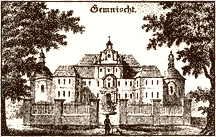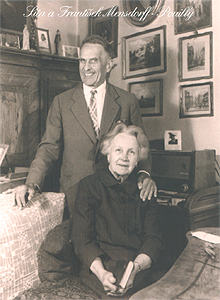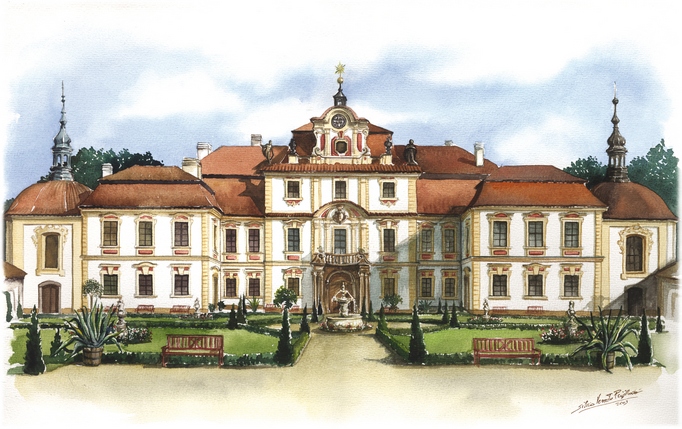History of the Chateau Jemniště
The first news of Jemniště dates back to the year 1381. At that time the owner of the manor was Beneš of Cimburk, who started to write from Jemniště according to the name of the village located here. The manor of course was not this château but a fortress surrounded by a moat, which is located in the nearby village up to now (see old chateau). In 1717 the manor was bought by Count Frances Adam of Trauttmansdorff (+ 1762), originally from an old Styrian family. The château in the village did not suit his tastes and demands. That is why about the year 1724, he had a new château built on a nearby hillock. The new château better fit his taste and standing as a pre-eminent aristocrat.
 The main designer of the project was the famous Czech architect Frances Maxmilián Kaňka. The construction proceeded very quickly. In October 1725 the construction was finished that is why the celebratory consecration of Saint Joseph´s chapel could take place. In 1754 the château completely burned down, only St. Joseph's chapel remained
The main designer of the project was the famous Czech architect Frances Maxmilián Kaňka. The construction proceeded very quickly. In October 1725 the construction was finished that is why the celebratory consecration of Saint Joseph´s chapel could take place. In 1754 the château completely burned down, only St. Joseph's chapel remained
intact. From this reason František Adam of Trauttmansdorff had the entire château rebuilt and newly furnished. That time the gable on the façade was changed and the Trauttmansdorff coat-of-arms was placed on it. The appearance of the château was completed by Lazar Widman´s statues. Besides these modifications the château did not undergo any substantial reconstructions. So, we have an ideal opportunity to see a typical aristocratic seat at the peak of the Baroque period.
The château is an elegant storeyed building designed mainly for summer living. The main façade is headed to the Benešov route.
The elegant gable and balcony domanite to the chateau, which emphasize the entrance to the château. The single-storey buildings on the sides of the building served for agricultural purposes – as stables and sheds. They are connected with the main building of the château at an almost right angle and create so-called courtyard of honour, the heart of a Baroque château layout. This is where carriages of the owners of the manor and the château guests used to arrive. It was exactly this place, where the count welcomed his most important visitors. The courtyard of honour was optically separated from the surrounding world by a decorative metal lattice and two-wing gate. This was not a fortress-type residence at all but a country villa, which primary purpose was the owner's comfort.
The rear facade of the château faces the park. During Frances Adan of Trauttmansdorff¨s time this was a French park, which has typical precise geometrical lines, statues and fountains. It was often used for holding garden celebrations and two garden houses were also built for this purpose.
At the turn of the 18th to the 19th century, the Baroque garden was changed into a romantic English park. The only reminders of the former French park are the layout of the courtyard of honour and the new flower garden on the right side of the château.
As Frances Adam of Trauttmansdorf did not have any descendants, his relative Joseph Wenceslas of Trauttmansdorf inherrited the chateau (+1769) but he died soon after Frances. That is why the owner of Jemniště became his widow Gabriela, born Czerninová, who married (1773) Count Henry Frances of Rottenhan (1738-1809).
Count Rottenhan was a high placed provincial official (he was the highest Prague burgrave) and thanks to the power of his office he supported the development of manufacturing. In this regard he was en example and under hir rule Jemniště became an important cotton industry centre in Bohemia. His spinning works and factory in nearby Postupice (Podlesí) even belonged among the most important in the Habsburg monarchy.
During the 19th century the château had many owners. In 1868 the manor was bought by Count Zdeněk Sternberg (1913-1900), owner of the nearby manor of Český Šternberk. As the fourth of five children of Count Joseph Leopold(1770-1858), he had no title to the family fideicommissum manor of Častolovice, which later went to his older brother Leopold (1811-1899). However, from his distant uncle Caspar Maria, Count of Sternberg he inherited the Radnice manor, where rich coal mines were found. It was the revenue from them that allowed Zdeněk to significantly multiply the family's proper. In 1841 he bought Český Šternberk from Count Somsiće of Sardu and in 1868 Jemniště from Prince Windisch-Graetze. He also considered buying Konopiště, which in the past also belonged to the Sternbergs. However, its owner, Prince Frances Eugene Lobkowicz, gave precedence to Archduke Frances Ferdinand d'Este. Because the Český Šternberk castle was not lived all year round (it mainly served as a hunting seat), the family mainly resided at the château of Březina at Rokycany.
After the death of Count Zdeněk, his eldest son Alois (1850-1907) inherited Český Šternberk and Radnice, and second-born Philip (1852-1924) inherited Jemniště. Because Alois died unmarried and without children, Philip became the sole inheritor of all these estates and also other family's residences in Vienna.
Philip of Sternberg carried out necessary repairs and raised Jemniště to the status of his main seat of residence. He married Countess of Thurn and Valsassina (1863-1944) and had two sons and two daughters. His older son Zdeněk died of joint rheumatism untimely and from this reason his second-born son Jiří Douglas (1888-1944, grandfather of the current owner) inherited bigger part of the property (Český Šternberk and Roudnice). Jemniště was equally devided between two daughters, Maria Gabriela (1890-1934) and Theresa (1902-1985). After Gabriela's death, the sole owner of Jemniště became Theresa (Sita), who married Frances, Count of Mensdorff-Pouilly (1897-1991).
 Sita and Frances owned Jemniště up to 1943. Because after the occupation of Czechoslovakia they refused to convert to German nationality, they (the same as Theresa's brother George Douglas) were exposed to all kinds of persecution. The greatest catastrophe occurred in 1943. The owner of a nearby manor Tloskov in Neveklovsko, where the German administration set up an exercise ground for the army of the SS, Oscar Daněk von Esse (descendent of the founder of ČKD Vincence Daněk), as a citizen of the Third Empire was entitled to compensation. He chose Jemniště. Because the Mensdorffs refused the forced sale, they had to move out within 14 days. However, they were able to move some of the chattels to the Český Šternberk castle, some to the château in Postupice and to the Postupice vicarage, where they later lived.
Sita and Frances owned Jemniště up to 1943. Because after the occupation of Czechoslovakia they refused to convert to German nationality, they (the same as Theresa's brother George Douglas) were exposed to all kinds of persecution. The greatest catastrophe occurred in 1943. The owner of a nearby manor Tloskov in Neveklovsko, where the German administration set up an exercise ground for the army of the SS, Oscar Daněk von Esse (descendent of the founder of ČKD Vincence Daněk), as a citizen of the Third Empire was entitled to compensation. He chose Jemniště. Because the Mensdorffs refused the forced sale, they had to move out within 14 days. However, they were able to move some of the chattels to the Český Šternberk castle, some to the château in Postupice and to the Postupice vicarage, where they later lived.
In Mai 1945 Jemniště was liberated by the Russian army under General Malinovský. However, the Russians considered the château, which at that time belonged to the Germans, as conquered territory and that is why not much remained from the original furnishings. In spite of the protests of the Mensdorffs, Jemniště was confiscated by the State. That is why Countess Sita requested the restitution of the property. At first her request was complied with but she never moved to the château.
In 1951, it was nationalized again, this time by the communist regime.
Theresa Mensdorff lived in nearby Postupice until her death in 1985. Her husband Frances died in 1991. Because they had no children, their nephew John Bosco Sternberg (1936 - 2012) inherited the title to Jemniště. The château and estate were returned into the hands of the Sternbergs in 1995.
The current owner is his son George, who resides with his family in the left wing of the château.
